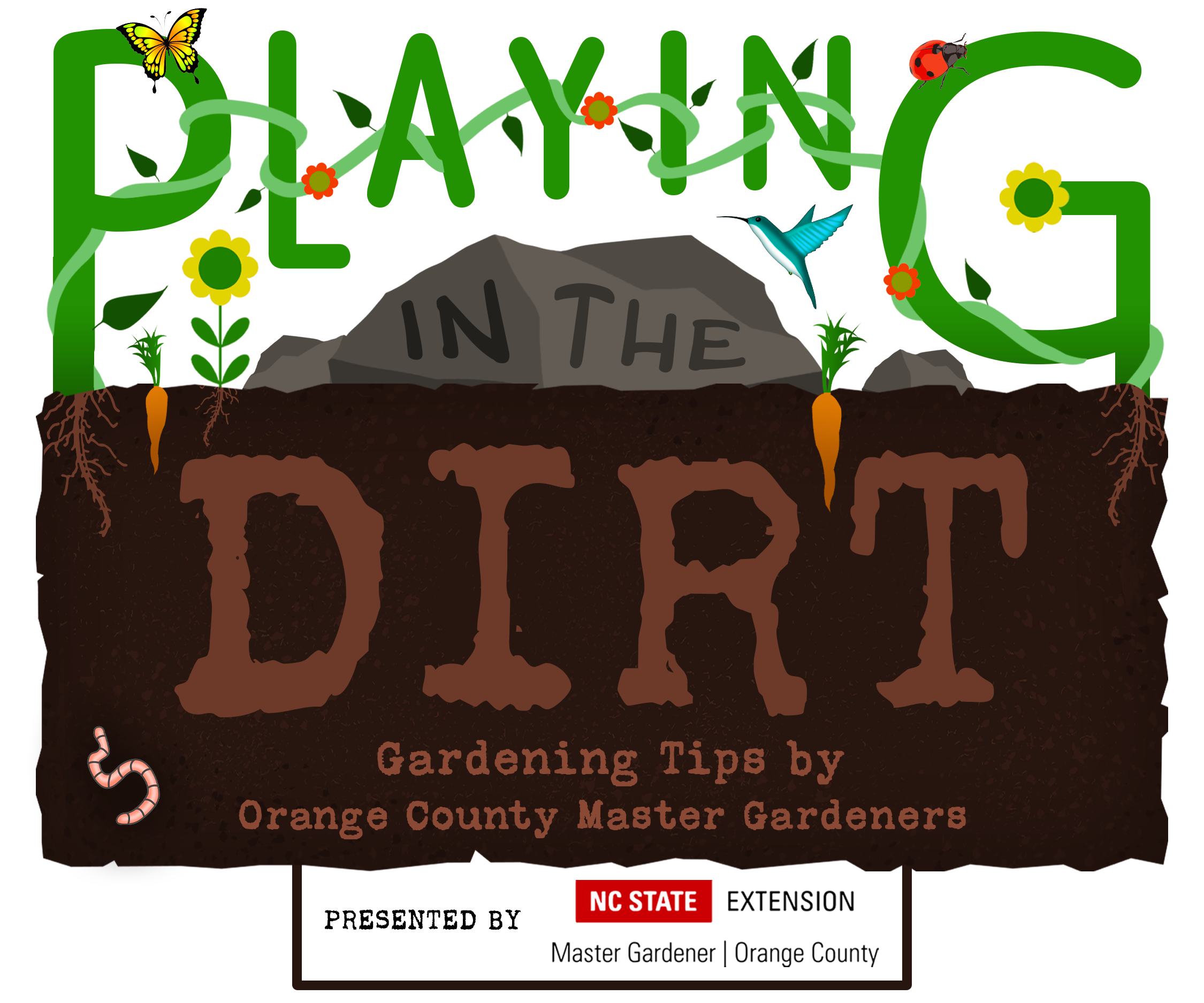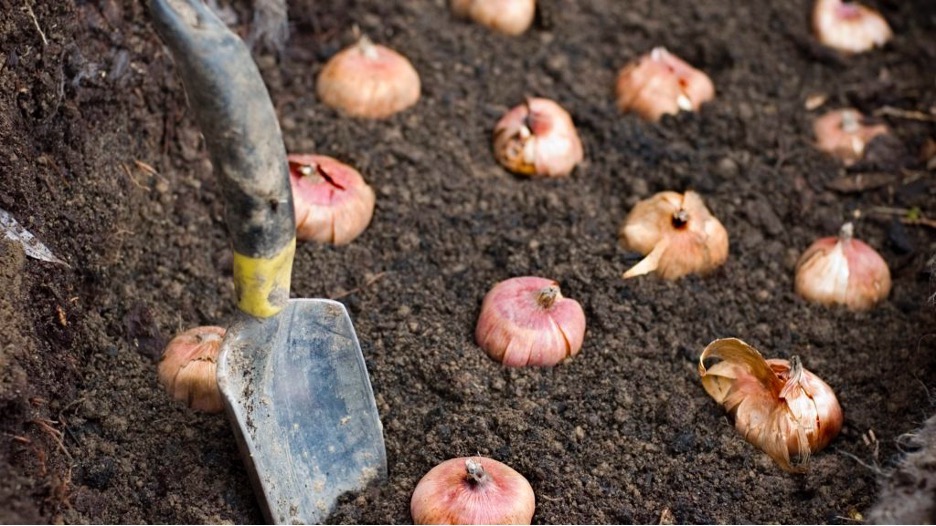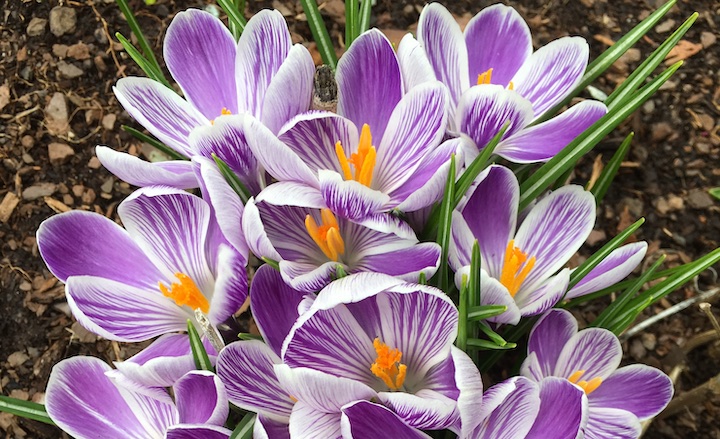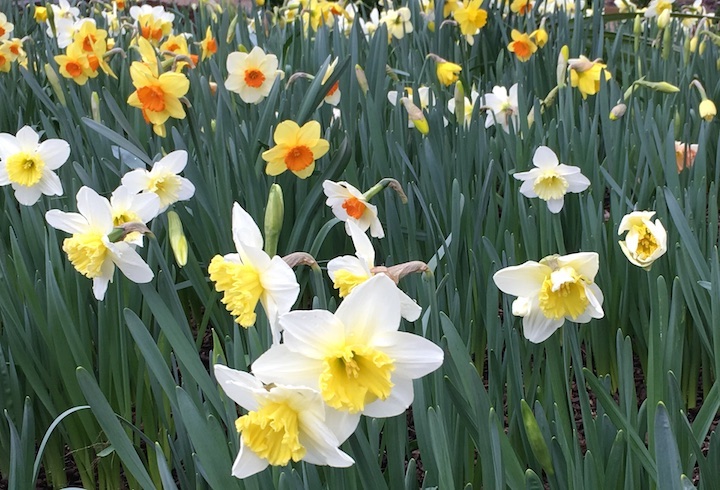
97.9 The Hill and Chapelboro.com have partnered with Orange County Master Gardeners for “Playing in the Dirt,” a monthly column exploring the fertile ground of home gardening in our community and intended to provide the information and inspiration gardeners of all skills levels need to flourish! Check back on Chapelboro each month for a new subject – from our gardens to yours!
By Lynn Calder , Orange County Master Gardener volunteer
Crocuses and daffodils and tulips, oh my! Visit any nursery or home-improvement store this time of year and bins of bulbs will beckon you to stock up.
Plant bulbs in the fall to enjoy the beautiful flowers that pop out from late winter to late spring, before most perennials and annuals are blooming. From the earliest blooming crocuses to daffodils, tulips, hyacinths and other bulbs, the vibrancy and color of these flowers are a welcome sight after winter.
When to Plant
Early fall is the best time to buy spring-flowering bulbs because supplies are plentiful then. But wait to plant them until mid-November to early December, when night temperatures in Orange County (Zone 7) are consistently below 60 degrees. The bulbs need a cold period to initiate flowers and enough time in the ground to develop a strong root system before spring growth.
When choosing bulbs, remember that bigger is better. Even if the bulb’s brown, papery outer layer is torn or missing, it should be healthy as long as it’s firm and not soft, mushy or moldy. If you buy bulbs early, store them in a ventilated bag or container (not a plastic bag!) in a cool, dry place at around 50 to 65 degrees until planting. You don’t want the bulbs to soften or sprout before you get them in the ground. If you store them in the refrigerator, keep them away from fruits and vegetables, which can produce ethylene – it can cause flowering problems in the bulbs.
How to Prepare the Garden for Bulbs
Most bulbs prefer full sun but you may have more location options than you think: deciduous trees often are still bare when spring flowering bulbs emerge and flower. Also, bulbs such as daffodils and crocuses tolerate partial shade.
Your plants will grow better if you know something about your soil. Test your soil! Good drainage and a pH between 6 and 7 are the most important soil factors for bulbs. For more information on soil, take a look at last month’s “Playing in the Dirt” column.

Plant spring-flowering bulbs in the fall. (Photo from North Carolina Cooperative Extension – Burke County Center)
You can plant bulbs in individual holes, but it is better to prepare a garden bed. A bed of loose, light soil 8 to 12 inches deep will make it easier to plant the bulbs and allow for better root growth. Mix in organic material, fertilizer and other amendments as indicated by your soil test.
If your bed contains clay soil, amend it with organic material to improve drainage. You can also plant your bulbs in a raised bed or large pot.
Planting depth depends largely on the size of the bulb. The general rule is to measure the bulb from top to bottom and plant it at a depth 2½ to 3 times that number. Set the bulb upright in the hole with the roots facing down. Space small bulbs 1 to 2 inches apart, medium bulbs 3 inches apart, and large bulbs 4 to 6 inches apart.
A 2-to-3-inch covering of organic mulch applied at planting or after the soil cools in winter will help keep soil temperature uniform, delay warming of the soil in spring and inhibit weed growth. Be sure to account for the mulch depth when determining how deep to plant the bulb.
Most of the spring flowering bulbs are perennials and will grace your garden for years to come. Some, such as daffodils, crocuses, grape hyacinths and snowdrops are beautiful planted in a scattered, natural manner.
Should You Apply Fertilizer?
Without annual applications of fertilizers, bulbs may diminish over time. Follow your soil test recommendations for what to apply. There are generally two choices for fertilizing:
1) Mix a balanced fertilizer into the area where you’re planting new bulbs (for example, 2 cups of 10-10-10 for every 10 square feet) and apply the same amount again when foliage emerges to about 2 to 3 inches (six to eight weeks before flowering), or
2) Apply a single application of a slow-release complete fertilizer according to the label instructions when you plant in the fall and each fall thereafter. Water after fertilizing.
Bonemeal is no longer recommended for fertilizing bulbs and may attract unwanted wildlife.
Care After Blooming
Faded blooms should be removed at the stem after your bulbs flower (“deadheading”) so they do not develop seedpods. Though it’s tempting to clean up yellowing foliage, let it dry out naturally (about 6 weeks for daffodils) rather than cutting it down or even braiding or tying it off. The fading leaves provide food for future plant growth. To camouflage the yellowing leaves, you can plant the bulbs among later growing perennials or add annuals to the bed. Once the leaves turn yellow, fall over and come loose when tugged, remove them to discourage disease growth.
Common Spring-Flowering Bulbs
Crocuses (Crocus) emerge and flower early, a sweet late winter surprise! The most common colors are lilac, mauve, yellow and white. The small flowers only last a day or so but you can plant 35 to 70 corms (bulbs) per square foot (2½ inches deep and 2 inches apart). Crocuses bloom year after year and naturalize well in both lightly wooded and sunny areas. They may need to be divided about every four years.
Daffodils (Narcissus) (also called jonquil and paper whites) may be the easiest to grow and hardiest spring flowering bulbs for Orange County gardens. Depending on the variety planted, the pale to bright-yellow fragrant flowers brighten up yards from late winter to early summer and make wonderful cut flowers. Daffodils can tolerate light shade, naturalize quickly and generally are not eaten by wildlife. Planted in a suitable area, daffodil bulbs grow bigger every year but flowering will decrease if they become crowded.

Tulips in bloom at the Arboretum at Tanglewood Park in Clemmons, NC. (Photo by Leslie Peck Rose, North Carolina Cooperative Extension, Forsyth County)
Tulips (Tulipa hybrids) come in a rainbow of colors, sizes and showiness. Tulips are perennials but often are treated like annuals in the South: most Dutch hybrids bloom only the first year after planting due to our warmer winters and hot, humid summers. Some cultivars can bloom more than one season in our area if they are planted and maintained properly. (Table 10-1 in Chapter 10 of the “North Carolina Extension Gardener Handbook” shows a list of these tulip cultivars.)
Hyacinths (Hyacinthus orientalis) are often seen blooming along with tulips in mid-spring. They will bloom in subsequent years as perennials if planted in a location with full sun and rich, well-draining soil. Over time, flowers may become smaller and more widely spaced. Cultivars produce highly fragrant flowers ranging from shades of blue, purple, pink, red and white.
Additional Resources
- Add Flowering Bulbs in Your Garden This Fall, by Leslie Rose, North Carolina Cooperative Extension (four videos)
- Plant Bulbs for Spring Color, by Charlotte Glen, North Carolina Cooperative Extension
- Recommended Fall-Planted, Spring-Flowering Bulbs | North Carolina Cooperative Extension
- North Carolina Extension Gardener Handbook, Chapter 10, Section VIII: Flowering Bulbs
- Have a plant or garden question for the Orange County Master Gardeners? Emailocmgardeners@gmail.com or phone 919-245-2061. Find plant information at The Orange Gardener and follow us on Facebook (search for OCEMGV).
Chapelboro.com does not charge subscription fees. You can support local journalism and our mission to serve the community. Contribute today – every single dollar matters.





